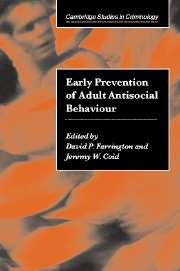Book contents
- Frontmatter
- Contents
- List of figures
- List of tables
- List of contributors
- Preface
- 1 Advancing knowledge about the early prevention of adult antisocial behaviour
- 2 Formulating strategies for the primary prevention of adult antisocial behaviour: “High risk” or ‘population’ strategies?
- 3 Risk factors for adult antisocial personality
- 4 Preventing the intergenerational continuity of antisocial behaviour: Implications of partner violence
- 5 Protective factors and resilience
- 6 Prevention during pregnancy, infancy and the preschool years
- 7 Prevention through family and parenting programmes
- 8 Prevention in the school years
- 9 Prevention of antisocial behaviour in females
- 10 Economic costs and benefits of primary prevention of delinquency and later offending: A review of the research
- 11 Conclusions and the way forward
- Index
- References
11 - Conclusions and the way forward
Published online by Cambridge University Press: 22 September 2009
- Frontmatter
- Contents
- List of figures
- List of tables
- List of contributors
- Preface
- 1 Advancing knowledge about the early prevention of adult antisocial behaviour
- 2 Formulating strategies for the primary prevention of adult antisocial behaviour: “High risk” or ‘population’ strategies?
- 3 Risk factors for adult antisocial personality
- 4 Preventing the intergenerational continuity of antisocial behaviour: Implications of partner violence
- 5 Protective factors and resilience
- 6 Prevention during pregnancy, infancy and the preschool years
- 7 Prevention through family and parenting programmes
- 8 Prevention in the school years
- 9 Prevention of antisocial behaviour in females
- 10 Economic costs and benefits of primary prevention of delinquency and later offending: A review of the research
- 11 Conclusions and the way forward
- Index
- References
Summary
Current knowledge about antisocial behaviour
In the past thirty years, a great deal has been learned about adult antisocial behaviour, as shown in the chapters of this book. It is known that most types of antisocial behaviour tend to be inter-related, in the sense that people who commit one type have an elevated probability of also committing other types. Hence, it is plausible to assume the existence of an antisocial syndrome, and that most types of antisocial acts basically reflect the same underlying theoretical construct, which might be termed an ‘antisocial personality’. However, less is known about the development of the antisocial syndrome, and especially about developmental sequences of antisocial acts, or the extent to which one type of act facilitates or is a stepping stone to other types. Also, little is known about the developmental course of careers of antisocial behaviour: about ages of onset, probability of persistence or escalation, frequency of different acts at different ages, duration of problems, or ages of desistance.
Many research projects focus on only one type of antisocial act, such as crime or drug use. More researchers should aim to measure a wide variety of different types of acts and hence the full antisocial syndrome. While precise definitions of antisocial personality disorder (APD), and cut-off points between normal and pathological, change over time, the constituent acts are well known.
- Type
- Chapter
- Information
- Early Prevention of Adult Antisocial Behaviour , pp. 356 - 368Publisher: Cambridge University PressPrint publication year: 2003
References
- 1
- Cited by



